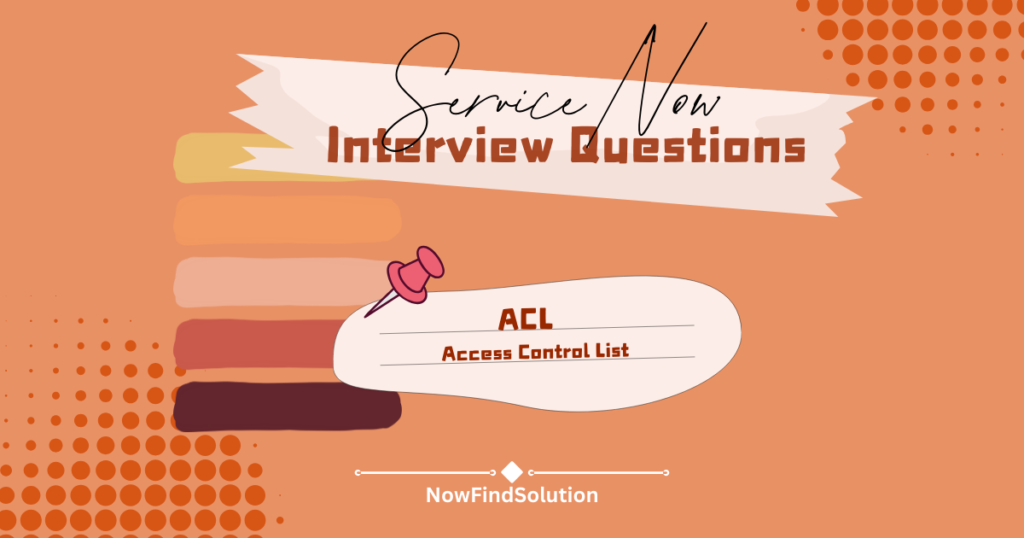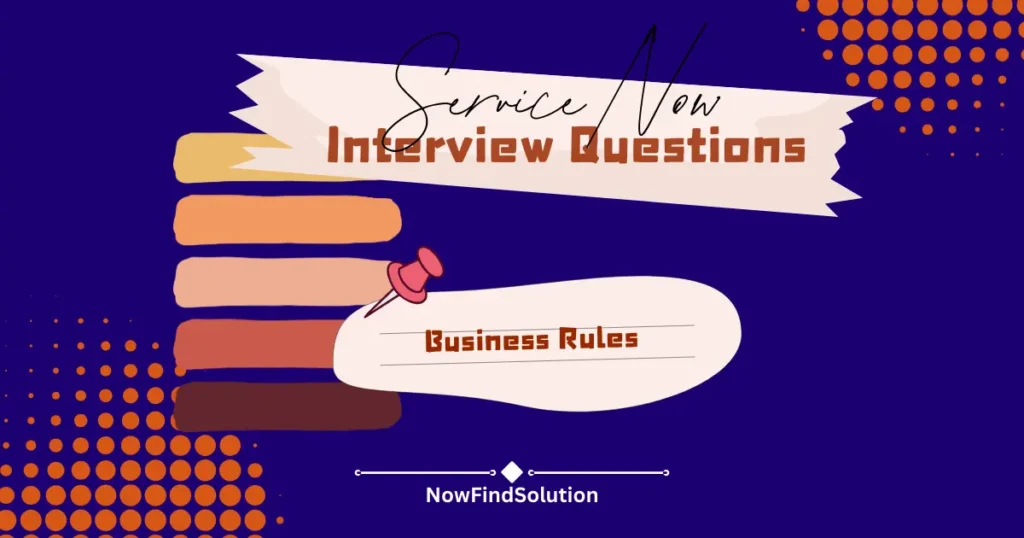Table of Contents
1. What is an ACL in ServiceNow?
An ACL (Access Control List) in ServiceNow controls who can access certain data and what actions they can perform.
Imagine you have a toy box with a lock. Only those with the key (permissions) can open the box (access data). ACLs act as this lock, deciding who can read, write, or delete data within the platform.
2. How do ACLs work in ServiceNow?
ACLs evaluate each request against conditions and scripts to allow or deny access.
Think of it like a bouncer at a party who checks if you’re on the guest list. If your name (user roles) is there and you meet the dress code (conditions), you’re allowed in (granted access).
3. What are the key components of a ServiceNow ACL rule?
An ACL rule consists of an object (e.g., table), operation (read, write, create, delete), and conditions.
Imagine a school’s entry gate: the object is the gate, the operation is entering, and the condition is having a student ID.
4. What is the role of the “Condition” field in an ACL?
The “Condition” field specifies criteria that must be met for access to be granted.
It’s like setting a rule: “Only people wearing red hats can enter.” If a user meets this condition, they gain access.
5. How do you use scripts in ServiceNow ACLs?
Scripts add advanced logic to ACLs, evaluating complex conditions.
Imagine you’re a librarian who only lends books to members with more than 10 book returns. The script checks this condition before allowing access.
6. What happens if multiple ACLs apply to the same data?
If multiple ACLs apply, ServiceNow ACL evaluates them in a specific order.
It’s like multiple gates before entering a secure building; you must pass through each gate (ACL) to proceed.
7. How does the “Admin Overrides” setting affect ACLs?
If “Admin Overrides” is enabled, admins bypass ACL checks.
It’s like having a master key that opens any door, regardless of the lock (ServiceNow ACL).
8. What is the purpose of the “Protected Field” checkbox in ACLs?
The “Protected Field” checkbox ensures that only certain users can see sensitive fields in ServiceNow ACL.
Imagine a diary with a lock; only those with the key can read the secret pages.
9. How does ServiceNow determine the order of ACL evaluation?
ServiceNow evaluates ACLs from most specific to most general, then by operation type.
Think of it like sorting mail; you first look at the exact address (specific ServiceNow ACL), then the street name (general ServiceNow ACL).
10. What is the significance of the “Decision Type” field in ACLs?
The “Decision Type” field dictates how access is determined, either allowing or denying based on specific conditions.
It’s like choosing between two paths: one that lets you in and another that blocks you.
11. Can you override a ServiceNow ACL for a specific user?
Yes, by creating a more specific ServiceNow ACL rule for that user.
It’s like making an exception for one person to enter a restricted area, even if others can’t.
12. What is the difference between table-level and field-level ACLs?
Table-level ACLs control access to the entire table, while field-level ACLs control access to individual fields.
It’s like having a door that grants entry to a house (table) and another door that restricts access to a specific room (field).
13. How can you test ACLs in ServiceNow?
ACLs can be tested using the “Impersonate User” feature or by using scripts in the Script Editor.
It’s like trying to unlock a door with different keys to see which ones work.
14. What is a “Custom Script” ACL, and when would you use it?
A “Custom Script” ServiceNow ACL allows for complex access logic through scripting.
It’s like setting up a security system that checks multiple factors before letting someone in, not just a simple lock.
15. How do you protect sensitive data in ServiceNow using ACLs?
Sensitive data can be protected by setting strict ServiceNow ACLs on fields that contain personal or confidential information.
It’s like putting a strong lock on a safe where you keep valuable items.
16. What is the purpose of the “Type” field in ACLs?
The “Type” field determines whether the ACL applies to a record, a field, or a list.
Imagine you have three doors: one to the entire house (record), one to a room (field), and one to a closet (list).
17. How does the “Protection Policy” affect ACLs?
The “Protection Policy” controls how an ACL can be modified or deleted.
It’s like putting a tamper-proof seal on a document to prevent unauthorized changes.
18. Can you apply an ACL to a UI Action in ServiceNow?
Yes, ACLs can be applied to UI Actions to control who can see or use them.
It’s like having a special button that only certain people can press.
19. What is the impact of the “Read Roles” field in a field-level ACL?
The “Read Roles” field specifies which roles can view a field’s content.
It is like permitting specific people to read a page in a book while others see only a blank page.
20. How does the “Local or Existing” setting relate to ACLs in the latest release?
The “Local or Existing” setting determines whether an ACL applies to newly created records or existing ones.
It’s like deciding if a new rule should apply to everyone or just to new visitors.
21. How do you create a table-level ACL?
To create a table-level ACL, specify the table, operation, and roles that have access.
It’s like setting a main gate rule that applies to anyone trying to enter the house.
22. What happens if there’s no ACL for a specific operation?
If there’s no ACL, ServiceNow denies access by default.
It’s like a door without a keyhole; you can’t enter unless someone creates a way in.
23. How does “Advanced Condition” differ from a regular condition in ACLs?
“Advanced Condition” allows scripting to evaluate more complex logic, whereas a regular condition uses simple criteria.
It’s like adding a security guard who asks questions before letting someone in, compared to just checking a list.
24. What is the role of “Requires Role” in an ACL?
“Requires Role” specifies which roles are needed to pass the ACL check.
It’s like needing a special badge to get into certain parts of a building.
25. How can ACLs affect performance in ServiceNow?
Complex or numerous ServiceNow ACLs can slow down data retrieval.
It’s like having too many security checks that delay entry into a building, creating a bottleneck.
FAQs
What is ACL in ServiceNow interview questions?
An ACL (Access Control List) in ServiceNow controls who can access certain data and what actions they can perform.
How many types of ACL are there in ServiceNow?
Table-Level ACL and Field-Level ACL
What is the difference between * and none in ACL?
* : Grant access to all fields
None : Grant access to records
How will ACL execute in ServiceNow?
Whenever the condition executes to True, ACL gets evaluated.
What ACL is used for?
ACLs evaluate each request against conditions and scripts to allow or deny access.


